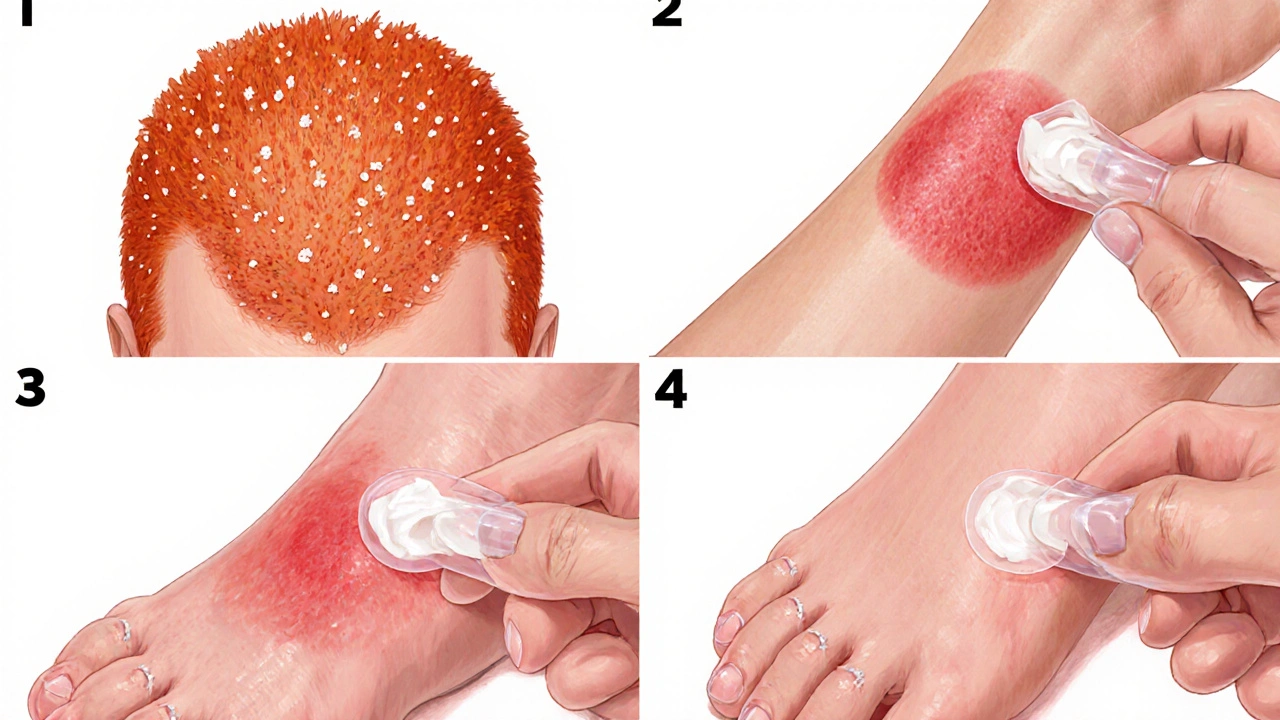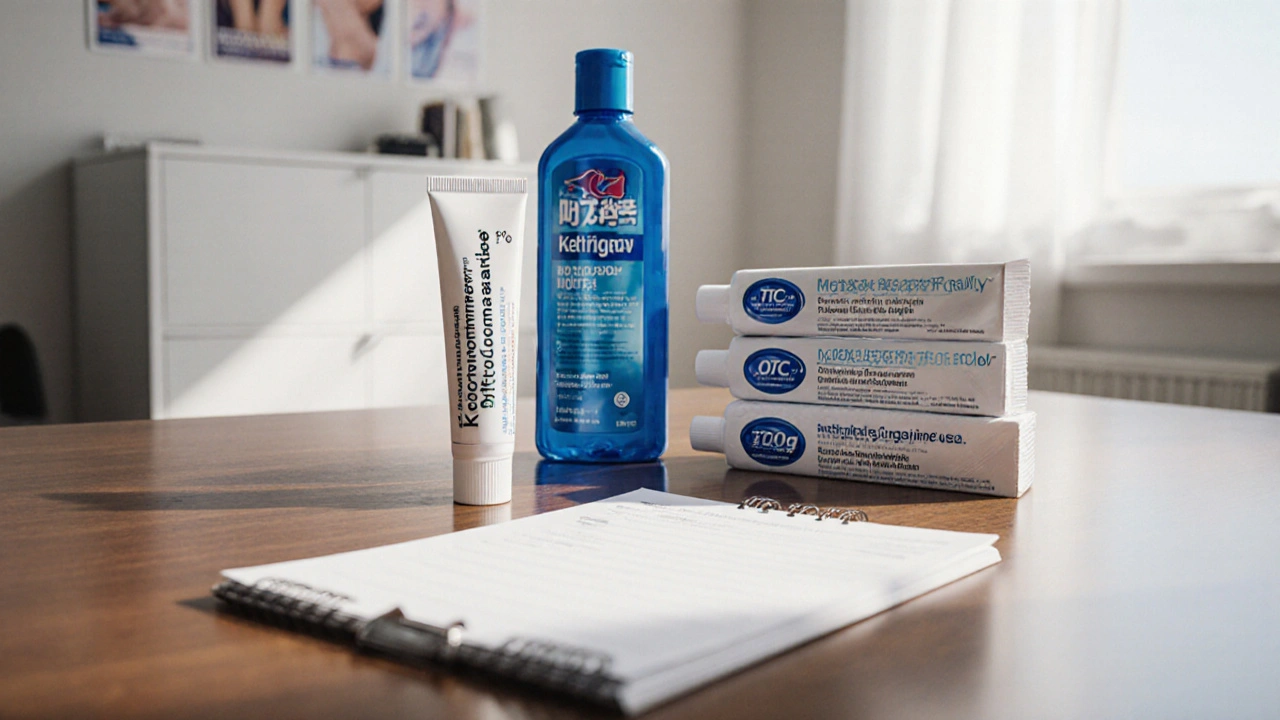When treating fungal skin infections, Ketoconazole cream is a topical antifungal medication that blocks the growth of fungi by inhibiting ergosterol synthesis. It’s a go‑to option for many doctors, but the market is crowded with other creams that promise similar results. If you’ve ever wondered whether you should stick with ketoconazole or try something else, this guide walks you through the key differences, pros and cons, and which situations call for each product.
Key Takeaways
- Ketoconazole cream is prescription‑only in the UK, typically 2% concentration, and shines for seborrheic dermatitis and dandruff.
- Clotrimazole and Miconazole are over‑the‑counter (OTC) options that work well for athlete’s foot and ringworm.
- Terbinafine offers the fastest symptom relief for tinea corporis but may cause more skin irritation.
- For mild dandruff, zinc pyrithione shampoo can be as effective as a prescription cream with fewer side effects.
- Choosing the right cream depends on the infection type, severity, prescription status, and how your skin reacts.
What Is Ketoconazole Cream?
Ketoconazole belongs to the imidazole class of antifungals. The cream is usually formulated at 2% (sometimes 1% for milder cases) and is applied once or twice daily for two to four weeks, depending on the condition. Its primary action is to inhibit the fungal enzyme lanosterol 14‑α‑demethylase, which halts the production of ergosterol-a crucial component of the fungal cell membrane. Without ergosterol, the fungus can’t maintain its structure and dies.
In the UK, the NHS often requires a prescription for ketoconazole cream, especially for scalp disorders like seborrheic dermatitis. This regulatory step ensures that a clinician assesses whether a stronger antifungal is warranted.
Common Skin Fungal Conditions Treated with Topical Antifungals
- Seborrheic dermatitis: Red, flaky patches on the scalp, face, or chest.
- Dandruff: Scalp scaling that may be itchy.
- Ringworm (tinea corporis): Circular, red lesions on the body.
- Athlete’s foot (tinea pedis): Itchy, burning feet, often between the toes.
- Jock itch (tinea cruris): Red rash in the groin area.
While many of these can be managed with OTC options, some cases-especially persistent scalp issues-respond better to prescription‑strength agents like ketoconazole.
How Ketoconazole Stacks Up Against Other Antifungal Creams
Below is a snapshot of the most common alternatives you’ll see on pharmacy shelves or receive from a GP. Each has a slightly different chemical class, concentration range, and recommended use‑case.
| Active Ingredient | Typical Concentration | Prescription Status (UK) | Common Uses | Treatment Duration | Typical Side‑Effect Profile |
|---|---|---|---|---|---|
| Ketoconazole | 2% (1% for mild) | Prescription | Seborrheic dermatitis, dandruff, tinea corporis | 2-4weeks | Skin irritation, rare allergic reaction |
| Clotrimazole | 1% (OTC) | OTC | Athlete’s foot, jock itch, ringworm | 1-2weeks | Mild burning, itching |
| Miconazole | 2% (OTC) | OTC | Foot fungus, groin rash, diaper rash | 2-4weeks | Transient redness |
| Terbinafine | 1% (OTC) | OTC | Ringworm, athlete’s foot, nail fungus | 1-2weeks | Possible skin peeling, rare systemic effects |
| Econazole | 1% (Prescription) | Prescription | Severe tinea infections, candidiasis | 2-3weeks | Itching, burning |
| Ciclopirox | 0.77% (Prescription) | Prescription | Dermatophyte infections, onychomycosis | 4-6weeks | Dryness, occasional erythema |
| Zinc Pyrithione | 1% (Shampoo) | OTC | Dandruff, mild scalp seborrheic dermatitis | Continuous use | Scalp dryness, rare irritation |

When to Pick Ketoconazole Over the Rest
If you’ve tried an OTC cream for a month and the rash persists, ketoconazole is often the next step. Its stronger antifungal activity makes it especially effective against Malassezia‑related scalp conditions. Here are three tell‑tale signs you might need it:
- Persistent scaling on the scalp or face despite regular zinc pyrithione or selenium sulfide shampoo.
- Inflammatory plaques that spread beyond the typical borders of athlete’s foot.
- Recurrence within weeks after completing an OTC regimen.
In those cases, a GP can prescribe a 2% ketoconazole cream, usually for a 2‑week course, followed by a maintenance phase with a milder shampoo.
Choosing the Right Alternative for Specific Conditions
Not every fungal problem needs a prescription. Below is a quick match‑up:
- Athlete’s foot: Clotrimazole or Miconazole (OTC) work fast and are inexpensive.
- Ringworm on the body: Terbinafine gives the quickest relief (often visible in 4‑5 days).
- Severe nail fungus: Ciclopirox or oral terbinafine are preferred, but topical ciclopirox can be a start.
- Mild dandruff: Zinc pyrithione shampoo offers a low‑risk, daily solution.
When side‑effects are a concern-especially for sensitive skin-start with the lowest‑strength OTC option and only move up if the infection doesn’t improve.
Practical Tips for Using Topical Antifungals Effectively
- Clean and dry the area before applying. Moisture fuels fungal growth.
- Apply a thin film and rub it in gently; thick layers can trap moisture.
- Follow the full course even if symptoms vanish after a few days.
- Avoid occlusive dressings unless your doctor advises; they can worsen irritation.
- Check for drug interactions if you’re using other topical steroids or systemic antifungals.
Remember, stopping a cream early can let the fungus rebound, leading to a chronic cycle.
Potential Pitfalls and How to Avoid Them
Even the best‑selling creams can backfire if misused. Common mistakes include:
- Skipping the prescription step: In the UK, using ketoconazole without a prescription means you might get a lower‑strength version that won’t control severe scalp disease.
- Mixing creams: Applying a steroid over an antifungal can mask symptoms and delay proper treatment.
- Using expired products: Potency drops after the expiry date, especially for creams stored in hot bathrooms.
When in doubt, a quick call to your pharmacist can clarify whether a product is suitable for your specific skin type.

Frequently Asked Questions
Can I buy ketoconazole cream over the counter in the UK?
No. In the United Kingdom, ketoconazole cream is classified as a prescription‑only medicine. You’ll need a GP’s prescription to obtain the 2% strength commonly used for scalp disorders.
How long does it take for ketoconazole cream to work?
Most patients notice reduced redness and scaling within 7-10days, but full clearance can take up to four weeks, especially for stubborn seborrheic dermatitis.
Is it safe to use ketoconazole cream on broken skin?
Apply only to intact skin. If the area is cracked or ulcerated, the cream can cause irritation and may be less effective. A healthcare professional can suggest an alternative formulation.
What should I do if I develop a rash after using an antifungal cream?
Stop using the product immediately and rinse the area with cool water. Contact your pharmacist or GP; the reaction could be an allergic response that requires a different medication or a short course of a mild steroid.
Are there natural alternatives to ketoconazole for dandruff?
Tea tree oil shampoos and aloe‑based scalp washes can help mild dandruff, but they lack the potent antifungal action of ketoconazole. For persistent cases, a medicated shampoo remains the most reliable choice.
